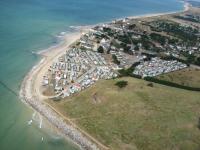› History
| Port-Bail is a base of ancient civilisation. It was already a stopover port on the route de l'étain, the ancient trade route running from the British Isles to the Mediterranean. At the time the coast extended right up to Jersey - sailors took full advantage of a port which was sheltered from the wind and regularly stopped off there. |  |
| | Activity in and around the port flourished until the advent of the
railway. The town lived through the Cotentin Christianisation period of
the 5th century. From this era, the ruins of the only hexagonal
baptistry found north of the river Loire are preserved to this day. In October 1999, archeologist François Delahaye restored the base of a fanum and a bell cast. The future of Port-Bail may lie in research into its past. |
| Many structures around the village dating back to the medieval period have been preserved. One in particular is the Port-Bail church of Notre Dame with its 11th century arched wooden knave and its fortified tower. Old residences around this area have stood the test of time - come and discover these manors and castles. | |
| | Today, Port-Bail is a small town with a 240-berth port. As well as offering peace and quiet for those in search of it, it offers others to chance to celebrate and holds various events all year round. The town has a full range of shops. |
Coats of arms
| THE PORT-BAIL COAT OF ARMS Hellouin family Blue shield with a gold chevron, with three gold stars along the chief, and a silver spearhead at the base Alexandre Hellouin, Noble Lord of Ancteville, Advisor of the Head Landdrost and Civil and Criminal Lieutenant of the Bailiwick of St Sauveur Lendelin. It came into the possession of Le Dicq after he married Françoise II in 1678, daughter of Jacques Levy, tax collector in Coutances. He inherited the Lanquetot Manor. Marc Antoine Hellouin, Lord of Mesnilbus, Councillor and First Lawyer to the King of the Norman Parliament. Charles Alexandre Hellouin, Knight, Lord of Port-Bail. Nicolas Alexandre Hellouin, Knight of Mesnil. Pancrace Hellouin, Lord of Besneville, Coucy, Le Dicq, Lanquetot and Le Mesnil. He married Marthe Duchemin de la Tour. He had only one daughter, Marthe Hellouin, who would marry in Besneville to René Bo. The fiefdom of Le Dicq still existed. It was the third seignorial manor to be built. We owe much to Pierre de Castel who settled in these parts after accomplices of the King of Navarre destroyed the old town of Dicq. It is now a farm just East of Port-Bail opposite the Gry hilltop. You can still see pretty turrets, mighty buttresses, the surrounding walls and a listed chimney. |  |
